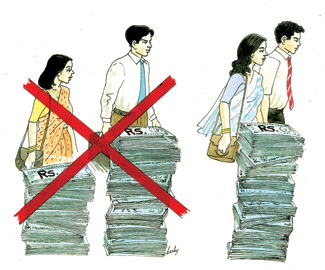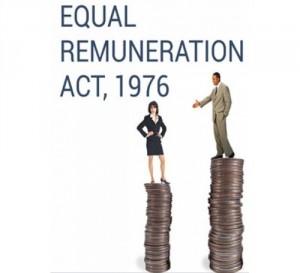In this blog post, Hari Manasa Mudunuri, a student of University College Of Law, Osmania University, who is currently pursuing a Diploma in Entrepreneurship Administration and Business Laws from NUJS, Kolkata, discusses the duties of an employer under the Equal Remuneration Act, 1976.
Introduction
In India, the Vedic period gave equal status to men and women, but this ideology had a tectonic shift over a period. The men have overshadowed the position of women in the society. At the time of Independence, the inequality was apparent, and the constitutional framers had to address this as it chose a democratic republic as a form of governance. Systems have to be put in place for the operation of the democratic forces to ensure equality. The constitutional provisions and various legislations have been enacted which became a bedrock towards ensuring equal opportunities to men and women. When equal opportunities are put in place, the next line of action needed is equal remuneration for the same work done without reference to the gender. To make this legislation a success, the onus is on the employer for effective implementation.
The employment of women has been increasing gradually over the years. Moreover, the works which were considered gender specific underwent a sea of change. Women were usually seen as less productive than their male counterparts. The general perspective of women was that they weren’t as serious as men in their work as family and home are their main priority. Economic dependency is the major cause for the women to have a weak bargaining power. This usually makes the employer take them for granted, and the wage rate would be unequal.
In the modern times, the women are no longer restricted to minimal jobs or the traditional works. They are employed at par with men and to protect their interests and ensure they get a fair chance, statutory recognition is given through different legislations, enacted both at center and state levels. The Workmen Compensation Act, Payment of Wages Act, Factories Act, Minimum Wages Act, The Equal Remuneration Act, Maternity Benefits Act, ESI Act, etc. are some of the legislations aimed at ensuring equal wages without gender bias.
Constitutional validity
Gender Justice is an important ingredient of every civilized society. It’s no longer the popular mindset that the female is a weaker sex. To imbibe this principle in the society, various steps were taken at the international level:
- The International Labour Organization held in 1951 a Convention concerning Equal Remuneration for Men and Women Workers for the Work of Equal Value.
- The Universal Declaration of Human Rights, under Article 23 ensures that everyone without any discrimination has the right to equal pay for equal work.
- The Convention on Elimination of all form of Discrimination, 1979 has it’s the main objective to prevent discrimination especially in the case of women.
At the national level, certain legislations were enacted by the British India. But it’s the national leaders, freedom fighters and intellectuals and the democratic movements sweeping the world over brought about positive changes in the position of women and in achieving equality.
- The Preamble of the Constitution provides for Justice and Equality to all.
- Article 14 equality before law
- Article 15 guarantees a right against discrimination
- Article 15(3) recognizes ‘protective discrimination’ to bring women at par with men in all possible respects.
- Article 16 provides right to equal opportunity regarding public employment irrespective of the sex of the person.
- Article 39(a) states that the citizens, men, and women, equally, have the right to an adequate means of livelihood.
- Article 39(d) “that there is equal pay for equal work for both men and women”.
- Article 42 requires the state to make provision for securing humane conditions of work and maternity relief.
The Doctrine of ‘equal pay for equal work’ is not a fundamental right but a Constitutional right. Equal remuneration for men and women is the right of an employee without any qualification. The Act of Equal Remuneration, 1976 was enacted to comply with the provisions of Directive Principle of State Policy (DPDP) under Article 39. The Act, being a beneficial legislation, ensures adequate payment or remuneration to be made irrespective of the physical strength of employee and removing the scope of social and economic injustice merely on the ground of sex, thereby working to establish a just society in the country.
The salient features of the Equal Remuneration Act, 1976
- The Act is a Central Legislation and applies to the whole of India.
- The objective of the Act is to provide for protection against discrimination of women workers on the ground of sex, about the payment of equal remuneration in the matter of employment.
- Restricting the employer to create terms and conditions in a contract of service or work of labor contrary to equal pay for equal work doctrine and the provisions of Equal Remuneration Act.
- The Act doesn’t make a distinction like employment or the period of employment and applies to all workers even if engaged only for a day or few days.
- No overriding effect is given to any agreement, settlement or contract to the provisions of the Equal Remuneration Act.
- Any settlement or any agreement with the employee that is detrimental to the employee isn’t allowed.
- The Ministry of Labour and The Central Advisory Committee are responsible for enforcing this Act.
- Meaning of equality of work: The equality of work is not based solely on the designation or the nature of work but also on factors like qualifications, responsibilities, reliabilities, experience, confidentiality, functional need and requirements commensurate with the position in the hierarchy are equally relevant.
- When the employer doesn’t comply with the provisions of the act, he will be liable to pay fine, imprisonment, or both.

The duties of the employer under the Act
-
Section 4: The duty of the employer to pay equal remuneration to both men and women workers for same work or work of similar nature
No employer shall pay to any worker, employed by him in an establishment or employment, remuneration, cash or in kind at rates less favorable than those at which he pays remuneration to the workers of the opposite sex for performing the same work or work of a similar nature.
- The rate of remuneration of any worker will not be reduced to avoid complying with Section 4(1).
- In respect of any establishment, the rates of remuneration payable before the commencement of the Act for men and women for same or similar nature work is different only on the ground of sex, then the highest of the rates will be payable after the commencement of the Act.
-
Section 5: No discrimination to be made while recruiting men and women workers
For any recruitment or any condition of service after recruitment like promotions, training or transfer, for the same or similar nature work, the employer will not make any discrimination against women except where the employment of women in such work is prohibited or restricted by or under any law for the time being in force.
Proviso: the provisions of the Act will not affect the priority given or reservation for SC, STs, ex-service men, retrenched employees.
-
Section 8: Maintaining a Registrar
Rule 6 read with Section 8 provides that: The employer has to maintain proper registers and relevant documents of all the employees and workers as prescribed by law in Form D. The Form needs to have:
- category of workers
- Description of work
- No, if men employed
- Number of women employed
- Rate of remuneration
- Components of remuneration.
-
Relevant case laws
The Indian Courts have played a major role in upholding the doctrine and ensuring proper enforcement of the social legislations for the benefit of the class of people the legislation was enacted for.
- A landmark case in the light of equal pay for equal work was the Judgment given by the Hon’ble Supreme Court in the case of Randhir Singh v. Union of India. Here, the Court adopted a sociological ideology and deviated from strict interpretation to liberal interpretation for the employees. The court, in this case, relied on ‘‘socialist’ as envisage in the Preamble to the Constitution in deciding the case, and it was held that the principle of equal pay for equal work was deducible from article 14 and 16 of the Constitution of India, may be properly applied to the cases of unequal scale of pay based on classification, though those drawing a different scale of pay do identical work under the same employer.” Here, the court observed that “equal pay for equal work” is deducible from Articles 14 &16, understood in the light of the Preamble and Art. 39(d).
Class or category of employee:
- M/s Mackinnon Mackenzie and Co. Ltd. v. Audrey D’Costa and other, 1987
In the given case, a woman employee was discriminated while payment of salary as the employer contended that the lady was working as a Confidential Stenographer and is part of a different class. The court rejected the plea of the employer that the woman was in a different class. It held, ‘If only women are working as Confidential Stenographers it is because the management wants them there. Women are neither specially qualified to be Confidential Stenographers nor disqualified on account of sex to do the work assigned to the male Stenographers. Even if there is a practice in the establishment to appoint women as Confidential Stenographer such practice cannot be relied on to deny them equal remuneration due to them under the Act.’ Therefore, the Court applied the Equal Remuneration Act to grant equal salary to female stenographers.
- Inder Singh & Others v. Vyas Muni Mishra & Others 1987
The court decided that when two groups of persons are in the same or similar posts performing the same kind of work, either in the same or in the different departments, equal pay will be paid to them by removing unreasonable discrimination and treating the two groups that are similarly situated, equally.
Meaning of same work or work of similar nature:
Mackinnon Mackenzie & Co. Ltd. v. Audrey D’Costa & Another, 1987
The court observed while determining the term ‘same work or work of similar nature’ under Section 2(h), the following are considered
- the authority should take a broad view
- ascertain if any differences are of practical importance, the authority should take an equally broad approach to the very concept of similar work implies differences in detail, but these should not defeat a claim for equality on trivial grounds.
- It should look at the duties performed, not those theoretically possible. In making comparison, the authority should look at the duties performed by men and women.
Relevance of conditions to employment:
Bhagwan Dass & Others v. State of Haryana & Others, 1987
The Court held that when it’s proved that the nature of duties and functions discharged and worked done similar, then the mode of selection and period of appointment is irrelevant and immaterial for the applicability of equal pay for equal work.
Constitutional relevance:
- Sita Devi & Others v. State of Haryana & Others, 1996
The learned Judge held that the “doctrine of equal pay for equal work is recognized as a facet of the equality clause contained in Article 14 of the Constitution.”
- S. Nakara v. Union of India:
A Constitutional Bench affirmed the decision in the case of Randhir Singh, in the given case. The Court held that “having regard to the constitutional mandate of equality and inhibition against discrimination in Articles 14 and 16, in service jurisprudence, the doctrine of “equal pay for equal work” has assumed the status of a fundamental right.”
 Serato DJ Crack 2025Serato DJ PRO Crack
Serato DJ Crack 2025Serato DJ PRO Crack















 Allow notifications
Allow notifications




[…] The whole point of providing service for an employee is fair and appropriate remuneration. Article 39(d) of the Constitution provides for equal pay for equal work. The laws under The Equal Remuneration Act, The Payment of Wages Act, mandates timely and fair remuneration of an employee. If an employee is not receiving his/her remuneration as per the employment agreement, can approach the Labour Commissioner or file a civil suit for arrears in salary. An employee cannot be given wages less than the legal minimum wages, as per law. A more detailed look into the remuneration under the Equal Remuneration Act is available in this article. […]
[…] The whole point of providing service for an employee is fair and appropriate remuneration. Article 39(d) of the Constitution provides for equal pay for equal work. The laws under The Equal Remuneration Act, The Payment of Wages Act, mandates timely and fair remuneration of an employee. If an employee is not receiving his/her remuneration as per the employment agreement, can approach the Labour Commissioner or file a civil suit for arrears in salary. An employee cannot be given wages less than the legal minimum wages, as per law. A more detailed look into the remuneration under the Equal Remuneration Act, is available in this article. […]